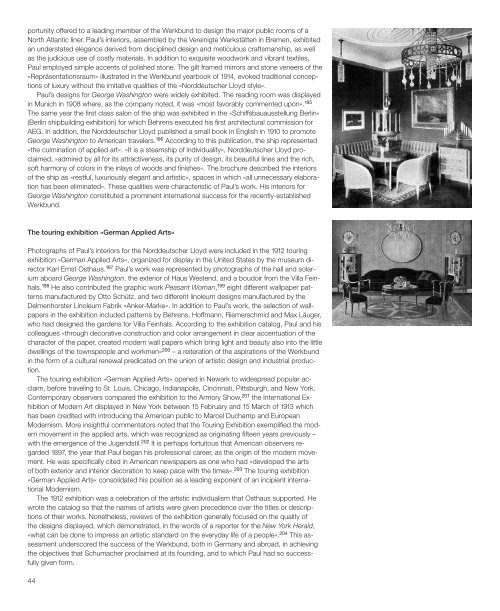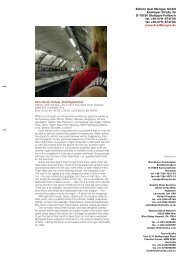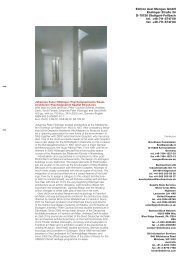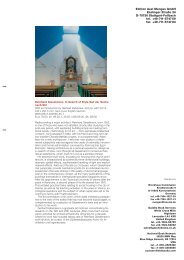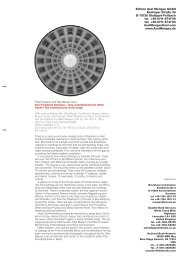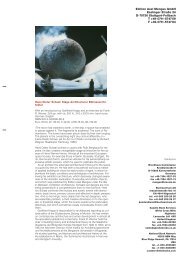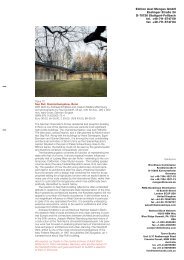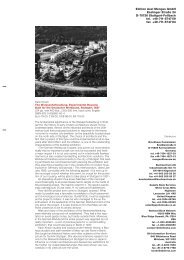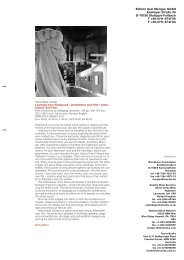Bruno Paul - Edition Axel Menges
Bruno Paul - Edition Axel Menges
Bruno Paul - Edition Axel Menges
Create successful ePaper yourself
Turn your PDF publications into a flip-book with our unique Google optimized e-Paper software.
portunity offered to a leading member of the Werkbund to design the major public rooms of a<br />
North Atlantic liner. <strong>Paul</strong>’s interiors, assembled by the Vereinigte Werkstätten in Bremen, exhibited<br />
an understated elegance derived from disciplined design and meticulous craftsmanship, as well<br />
as the judicious use of costly materials. In addition to exquisite woodwork and vibrant textiles,<br />
<strong>Paul</strong> employed simple accents of polished stone. The gilt framed mirrors and stone veneers of the<br />
»Repräsentationsraum« illustrated in the Werkbund yearbook of 1914, evoked traditional conceptions<br />
of luxury without the imitative qualities of the »Norddeutscher Lloyd style«.<br />
<strong>Paul</strong>’s designs for George Washington were widely exhibited. The reading room was displayed<br />
in Munich in 1908 where, as the company noted, it was »most favorably commented upon«. 195<br />
The same year the first class salon of the ship was exhibited in the »Schiffsbauausstellung Berlin«<br />
(Berlin shipbuilding exhibition) for which Behrens executed his first architectural commission for<br />
AEG. In addition, the Norddeutscher Lloyd published a small book in English in 1910 to promote<br />
George Washington to American travelers. 196 According to this publication, the ship represented<br />
»the culmination of applied art«. »It is a steamship of individuality«, Norddeutscher Lloyd proclaimed,<br />
»admired by all for its attractiveness, its purity of design, its beautiful lines and the rich,<br />
soft harmony of colors in the inlays of woods and finishes«. The brochure described the interiors<br />
of the ship as »restful, luxuriously elegant and artistic«, spaces in which »all unnecessary elaboration<br />
has been eliminated«. These qualities were characteristic of <strong>Paul</strong>’s work. His interiors for<br />
George Washington constituted a prominent international success for the recently-established<br />
Werkbund.<br />
The touring exhibition »German Applied Arts«<br />
Photographs of <strong>Paul</strong>’s interiors for the Norddeutscher Lloyd were included in the 1912 touring<br />
exhibition »German Applied Arts«, organized for display in the United States by the museum director<br />
Karl Ernst Osthaus. 197 <strong>Paul</strong>’s work was represented by photographs of the hall and solarium<br />
aboard George Washington, the exterior of Haus Westend, and a boudoir from the Villa Feinhals.<br />
198 He also contributed the graphic work Peasant Woman, 199 eight different wallpaper patterns<br />
manufactured by Otto Schütz, and two different linoleum designs manufactured by the<br />
Delmenhorster Linoleum Fabrik »Anker-Marke«. In addition to <strong>Paul</strong>’s work, the selection of wallpapers<br />
in the exhibition included patterns by Behrens, Hoffmann, Riemerschmid and Max Läuger,<br />
who had designed the gardens for Villa Feinhals. According to the exhibition catalog, <strong>Paul</strong> and his<br />
colleagues »through decorative construction and color arrangement in clear accentuation of the<br />
character of the paper, created modern wall papers which bring light and beauty also into the little<br />
dwellings of the townspeople and workmen« 200 – a reiteration of the aspirations of the Werkbund<br />
in the form of a cultural renewal predicated on the union of artistic design and industrial production.<br />
The touring exhibition »German Applied Arts« opened in Newark to widespread popular acclaim,<br />
before traveling to St. Louis, Chicago, Indianapolis, Cincinnati, Pittsburgh, and New York.<br />
Contemporary observers compared the exhibition to the Armory Show, 201 the International Exhibition<br />
of Modern Art displayed in New York between 15 February and 15 March of 1913 which<br />
has been credited with introducing the American public to Marcel Duchamp and European<br />
Modernism. More insightful commentators noted that the Touring Exhibition exemplified the modern<br />
movement in the applied arts, which was recognized as originating fifteen years previously –<br />
with the emergence of the Jugendstil. 202 It is perhaps fortuitous that American observers regarded<br />
1897, the year that <strong>Paul</strong> began his professional career, as the origin of the modern movement.<br />
He was specifically cited in American newspapers as one who had »developed the arts<br />
of both exterior and interior decoration to keep pace with the times«. 203 The touring exhibition<br />
»German Applied Arts« consolidated his position as a leading exponent of an incipient international<br />
Modernism.<br />
The 1912 exhibition was a celebration of the artistic individualism that Osthaus supported. He<br />
wrote the catalog so that the names of artists were given precedence over the titles or descriptions<br />
of their works. Nonetheless, reviews of the exhibition generally focused on the quality of<br />
the designs displayed, which demonstrated, in the words of a reporter for the New York Herald,<br />
»what can be done to impress an artistic standard on the everyday life of a people«. 204 This assessment<br />
underscored the success of the Werkbund, both in Germany and abroad, in achieving<br />
the objectives that Schumacher proclaimed at its founding, and to which <strong>Paul</strong> had so successfully<br />
given form.<br />
72. Thirteen-armed candelabrum, 1901. Manufactured<br />
by the Vereinigte Werkstätten and exhibited in Dresden<br />
in 1906, in a room designed by F. A. O. Krüger.<br />
Compare this room with <strong>Paul</strong>’s »Arbeitszimmer« from<br />
the same exhibition.<br />
73. <strong>Paul</strong>’s official residence, Berlin, 1914. Salon.<br />
74. <strong>Bruno</strong> <strong>Paul</strong>, circa 1914.<br />
75. <strong>Paul</strong>’s official residence, Berlin, 1914. Living room<br />
of the new residence of the director on the grounds of<br />
the school of applied arts.<br />
<strong>Paul</strong>’s residence in Berlin<br />
In 1914, <strong>Paul</strong> rebuilt his official residence in the buildings of the school of applied arts on Prinz-<br />
Albrecht-Straße, a project that epitomized his artistic beliefs. The furniture that he designed for<br />
this, his own home, reflected the elegance, refinement and cultural harmony of his commissioned<br />
interiors on the eve of the First World War. <strong>Paul</strong>’s living room embodied the timeless virtues of anthropometric<br />
proportions, signified by the conscientious use of the antique orders, by the inclusion<br />
of rare and inherently beautiful materials such as mahogany, crystal, and marble, and in the<br />
harmonious and muted coloration of painted, stained and dyed surfaces.<br />
The interiors that <strong>Paul</strong> designed for his residence also demonstrated the position that he himself<br />
had attained in Berlin society. As a royal professor he was numbered among the »hoffähig«,<br />
the privileged circle entitled to appear at court. In addition to his own work, his residence contained<br />
etchings by Piranesi, Tang bronzes, and European antiques. Such symbols of refined culture<br />
reinforced <strong>Paul</strong>’s identity as a person of taste and of means. His personal life echoed his material<br />
success; he was a frequent traveler and an accomplished horseman. 205 Moreover, the former<br />
Simplicissimus illustrator had attained the dignity of official recognition. He had been admitted<br />
to the Prussian royal academy in 1907. 206 In 1911, he received the Prussian order of the red<br />
eagle (Roter Adlerorden), an honor bestowed by the Kaiser for service to the crown. 207 By 1914,<br />
he had fulfilled the parental aspirations that had dispatched him to Dresden in 1896. The rebellious<br />
spirit of youth had led him to a lofty position in the Prussian civil service, material prosperity,<br />
and the patronage of the imperial government.<br />
In addition to artifacts of aristocratic culture, <strong>Paul</strong> displayed venerable objects of his own design<br />
in his Berlin residence. The thirteen-armed candelabrum that he designed for the Vereinigte<br />
Werkstätten in 1901 was prominently displayed. Despite such symbols of continuity, <strong>Paul</strong>’s residence<br />
also indicated emerging changes in his career. His furnishings were not produced by the<br />
Vereinigte Werkstätten, but likely by the Berlin firm Herrmann Gerson, purveyors of furniture to the<br />
imperial court. Moreover, many of the pieces <strong>Paul</strong> conceived for his own home reflected a far<br />
looser interpretation of the solid, practical elegance of eighteenth-century designs than his earlier<br />
work. By 1914 <strong>Paul</strong> was seeking a cultural ideal more expressive and elaborate than simple, Biedermeier<br />
Classicism. This search prefigured the next phase in his artistic career.<br />
44 45


